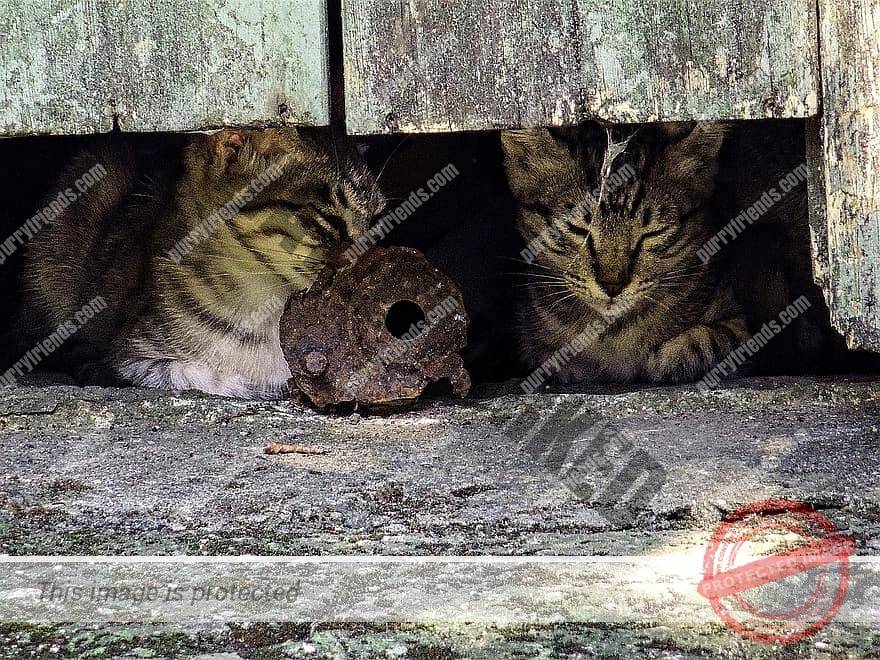Feral Cats Have it Hard in the Winter
Most places in the U.S. have significant populations of feral cats, and though cats seem tough and self-sufficient, it can be difficult for them to find safe shelter, especially in the winter months. If you live in a part of the world where winters are cold, and you have a DIY streak, you can help! There are many ways to put together a simple yet warm and safe shelter.
Requirements for a Safe Winter Shelter
- Clearing Snow: Make sure to clear snow away from the door after a heavy snow, or the cat will be trapped inside. Obviously, this is vitally important!
- Elevation: A shelter resting against the ground in winter will soak in all that cold, making it harder for a feral cat to warm up their surrounding with the warmth of their own body. Elevation of a couple of inches allows for straw or other insulating material to be packed under the shelter. Elevation also makes it less likely that rain will flood in. Just place the shelter on top of two 2X4 pieces of wood.
- Insulation: An enclosed shelter without insulation is little more than a windbreaker. Foam coolers work best as an outside shelter because of their insulating properties. An added benefit is the ease with which an opening can be cut. A cheap foam cooler such as one used for beach trips will do, but better yet would be a heavier cooler such as those food is delivered in for restaurants. These are usually discarded, so call around and you’ll be able to find one. You can also do a search online for foam shipping coolers.
- Appropriate Openings: Make the door opening small (5.5-6 inches) to discourage visits from raccoons. It should be several inches above the floor of the shelter. If you want to include two doors so cats will be able to escape intruders, the doors should have flaps so wind won’t blow through.
- Bedding: Though the shelter is enclosed to keep out rain and snow, cats will bring wetness in with them on their fur. For this reason, straw bedding is best for outdoor shelters. Straw doesn’t absorb water as blankets or conventional cat beds do. It has insulating properties, because the stalks are hollow, and that trapped air holds heat. Any bedding will need to be replaced with fresh regularly.
- Snug Space: A large shelter means more air to heat up, so smaller generally is better. Obviously, the number of cats in the area is a factor. If your shelter is likely to be used by more than one cat, more room inside is appropriate. You can take up some of the space in the cooler with extra pieces of foam, or simply add more straw to fill in some of the space.
- Safe Space: If there are stray dogs in the area, make sure the shelter is in a location dogs can’t reach. If a fenced in area isn’t available, face the opening against a wall, leaving room small enough so that only a cat can squeeze through. Elevating the shelter to a level above a dog’s reach is also a possibility.
- Stability: This one many people don’t consider. Foam coolers are extremely light, so you’ll need to weigh the cooler down with something heavy like flat rocks, paving bricks or plywood to stabilize it. Otherwise it could be caught in the wind, movement of cats inside could shift it, or dogs or other predators could tip it over.
Optional features
- Heating pad: For safety, be sure to use a heating pad and extension cord rated for outdoor use, or use a self-warming pad.
- Roof overhang: If the cooler is positioned with the door facing a wall, it is easy to position the plywood on the roof so that it touches the wall, offering covering over the door. This will help prevent rain or snow from getting in.
- Slight Incline: A slight incline will help keep water or snow from building up on the roof. If you’re using 2X4s for a stand, place one on end and one flat to achieve a slight incline.
- Ventilation: During warmer temperatures, you may want to drill holes high up in the walls on opposite sides so air can move through. Keep the holes small (no more than an inch) so they can be plugged in colder weather.
- Flooring: If you have a piece of vinyl, plastic, plywood, etc. to place on the floor of the cooler, the cats will be unable to claw at the foam under their straw bedding.
- Paint: Dark paint will help keep the shelter from drawing attention.
![]() The Best Bedding for Outside Cats
The Best Bedding for Outside Cats
As an Amazon Associate I earn from qualified purchases.

